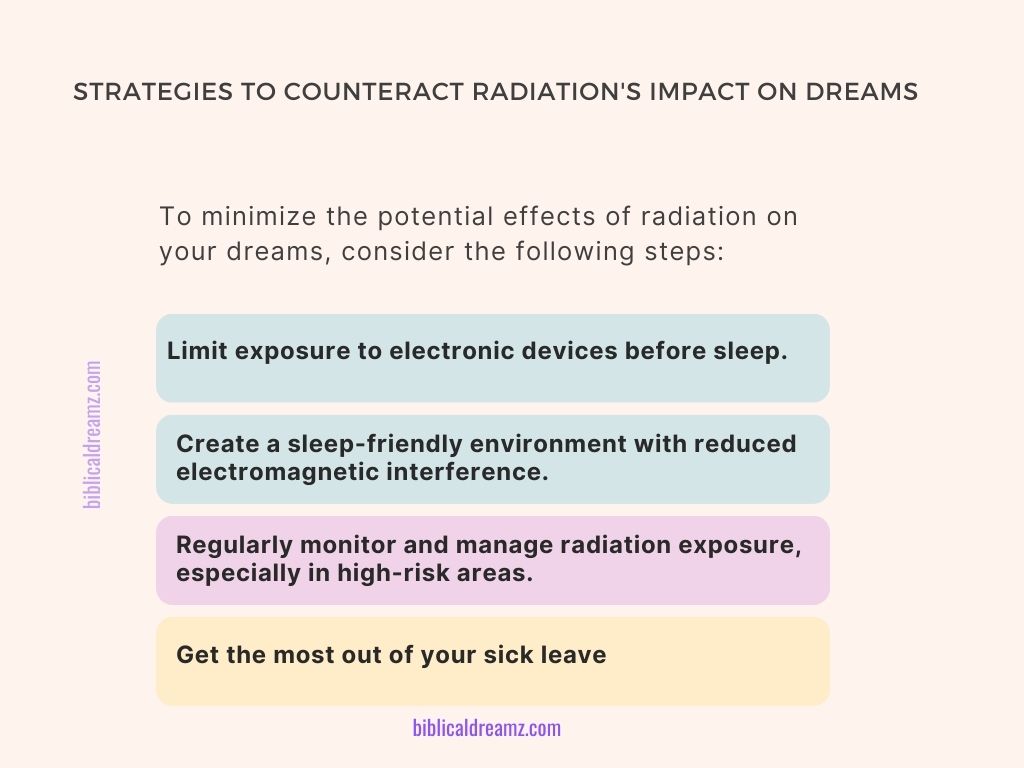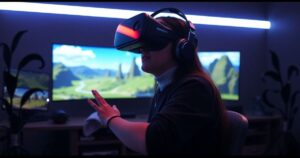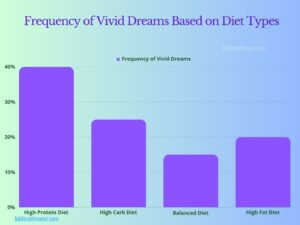Radiation’s Surprising Effects on Dreams: How Exposure Can Alter Sleep and Imagination
Radiation exposure, whether from cancer treatment or cosmic rays in space, can have unexpected effects on a person’s dreams. Studies show that radiation can change the vividness, bizarreness, and emotional intensity of dreams.
It may also disrupt sleep patterns and circadian rhythms. Grasping the effects of radiation on dreaming sheds light on the intricate interplay among the brain, sleep, and the imaginative process.
Key Takeaways:
- Radiation therapy for cancer can cause vivid, colorful dreams in some patients
- Cosmic radiation in space may lead to strange, unsettling dreams for astronauts
- Radiation exposure can alter sleep cycles and disrupt the circadian rhythm
- Dream changes from radiation are likely due to effects on the brain’s electrical activity
- Protecting against excess radiation exposure may help maintain normal, healthy dreaming
Related: How Does Your Diet Affect Your Dreams
Introduction
Radiation can alter a person’s dreams in surprising ways, causing exceptionally vivid imagery, bizarre scenarios, and strong emotions. Cancer patients undergoing radiation therapy have reported suddenly dreaming in color for the first time. Astronauts exposed to cosmic radiation often experience strange, unsettling dreams and restless sleep.
By disrupting the brain’s electrical activity and sleep-wake cycles, radiation may open a door to more intense dreaming and imagination. Studying this phenomenon sheds light on the mysterious link between radiation, the sleeping brain, and the world of dreams.

Cancer Radiotherapy and Vivid Dreams
One of the most dramatic examples of radiation’s impact on dreaming comes from cancer patients receiving radiotherapy. In a fascinating case study, Australian researchers described a 59-year-old man who began experiencing “rapid, vivid colored dreams” during his treatment for a brain tumor.
Get instant dream insights with our Free Dream Interpretation App
For the first time in his life, he reported dreaming in rich, vibrant hues – from “three-dimensional algebra equations” to “various species of fish he’d caught.” His technicolor dreams persisted throughout the month-long radiation therapy.
What could explain this sudden explosion of colorful dreaming? The researchers proposed that the brain tissue swelling and irritation caused by the radiation may have triggered unusual electrical activity, activating regions involved in visual processing and memory.
Another possibility is that the treatment schedule was disrupting the patient’s sleep cycles, causing him to wake more frequently during REM sleep – the stage most associated with vivid dreams.
This case adds to other reports of cancer patients experiencing changes in sleep and dreaming during radiotherapy:
Radiation Side Effect | Prevalence |
|---|---|
Insomnia | 30-50% |
Fatigue | 80-90% |
Vivid dreams | Case reports |
While intense dreaming seems to be a rarer side effect compared to insomnia and fatigue, it underscores the profound ways that radiation can alter the sleeping brain. More research is needed to understand the neurological mechanisms behind these dream changes and their impact on patients’ sleep quality and emotional well-being.
Cosmic Radiation and Astronauts’ Dreams
Venturing beyond Earth’s protective magnetic field exposes astronauts to higher levels of cosmic radiation – energetic particles that can penetrate the body and brain. Scientists are increasingly concerned about the neurological risks of this deep space radiation, including impaired cognition, dementia, and disrupted sleep.
Anecdotal reports suggest that cosmic radiation may also shape astronauts’ dream experiences. In his book “Endurance: A Year in Space,” astronaut Scott Kelly describes the vivid, bizarre dreams that became a nightly occurrence during his time on the International Space Station:
“In my dreams, I am often in a spacecraft or some kind of aircraft, frequently in an emergency situation. Sometimes I am fighting or wrestling with someone, or running from something scary, like a bear. Other times, the dreams are exceptionally vivid and realistic, as if I’m watching a movie of my life.”
While radiation is just one of many stressors that could influence astronauts’ dreams, some researchers believe it may play a key role by altering the brain’s electrical rhythms.
A 2019 study found an association between low geomagnetic activity – which allows more cosmic radiation to reach Earth – and more bizarre, disconnected dream content. The authors proposed that radiation exposure could disrupt the coordinated brain activity that normally keeps dreams relatively realistic and coherent.
As NASA plans for longer missions to the Moon and Mars, protecting astronauts from the neurological impact of chronic radiation exposure is a major priority. Strategies could include:
- Improved spacecraft shielding
- Pharmacological countermeasures (e.g. antioxidants, anti-inflammatory drugs)
- Monitoring and optimizing sleep-wake schedules
- Psychological support for coping with sleep disturbances and unsettling dreams
By safeguarding astronauts’ brains and sleep, these measures may help maintain the mental acuity and emotional resilience needed for the challenges of long-duration spaceflight.
Related: The Impact of Financial Status on Your Dreams
Radiation’s Impact on Sleep and Circadian Rhythms
Beyond its direct effects on dream content, radiation exposure can profoundly disrupt sleep patterns and the body’s internal clock. The circadian rhythm orchestrates the 24-hour cycle of physiological processes, including the sleep-wake cycle.
Light is the primary cue for synchronizing this rhythm, but research suggests that radiation may also play a role by altering the brain’s time-keeping mechanisms.
Studies on animals and humans have found that radiation exposure can cause:
- Fragmented sleep and frequent awakenings
- Reduced REM sleep
- Altered expression of clock genes that regulate circadian timing
- Melatonin suppression, leading to difficulty falling asleep
These effects may be especially pronounced for shift workers in nuclear power plants or medical facilities, who are exposed to both radiation and irregular light-dark schedules. Over time, chronic circadian disruption can take a heavy toll on physical and mental health, increasing the risk of:
- Metabolic disorders like obesity and diabetes
- Cardiovascular disease
- Cognitive impairment and mood disorders
- Certain types of cancer
Protecting the circadian rhythm is therefore crucial for people exposed to radiation in occupational or medical settings. Strategies may include optimizing work schedules, minimizing night shift rotations, and using blue light-blocking glasses to support the natural sleep-wake cycle.
Regular exercise, a healthy diet, and stress management techniques can also help strengthen the body’s resilience to circadian disruption.
The Neurological Basis of Radiation-Induced Dream Changes
While the exact mechanisms are still being unraveled, radiation’s impact on dreaming likely stems from its effects on the brain’s electrical activity and neurochemistry. During REM sleep, the brain becomes highly activated, with electrical oscillations and neurotransmitter levels resembling the waking state. This REM activation is thought to underlie the vivid, immersive quality of dreams.
Radiation exposure may alter these REM sleep processes in several ways:
- Disrupting electrical rhythms: Radiation can ionize atoms and disrupt the coordinated electrical activity of neurons. This could lead to more random, disjointed dream narratives and bizarre content.
- Altering neurotransmitter levels: Radiation has been shown to affect the brain’s dopamine, serotonin, and glutamate systems, which regulate mood, attention, and memory. Imbalances in these neurotransmitters could influence the emotional tone and content of dreams.
- Triggering inflammatory responses: Radiation can cause neuroinflammation, activating immune cells in the brain. This inflammatory signaling may affect neural circuits involved in sleep and dreaming.
- Damaging sleep-regulating regions: Certain brain areas, such as the hypothalamus and brainstem, are critical for regulating sleep and generating REM activity. Radiation damage to these regions could disrupt the normal dreaming process.
Unraveling the precise neurological pathways will require more research, integrating insights from sleep medicine, radiation biology, and neuroscience. Advanced brain imaging techniques, such as functional MRI and EEG, could help map the real-time effects of radiation on the sleeping brain’s activity patterns.
Animal studies may also provide clues by allowing more controlled experiments on the neurochemical and molecular changes induced by radiation.
As we gain a deeper understanding of how radiation affects the dreaming brain, we may be able to develop targeted therapies to mitigate any negative effects on sleep and cognitive function. This could involve drugs that stabilize neurotransmitter levels, reduce inflammation, or protect sensitive brain regions.
Non-pharmacological approaches, such as cognitive behavioral therapy and dream rehearsal techniques, may also help people cope with disturbing or disruptive dream content.
Ultimately, the goal is to harness the power of sleep and dreaming for healing and resilience in the face of radiation exposure. By supporting the brain’s natural recovery processes, we may be able to enhance the restorative potential of sleep and promote optimal cognitive function.
Protecting Sleep and Dreaming in a Radiation-Exposed World
As our understanding of radiation’s impact on sleep and dreaming grows, so does the importance of protecting these vital functions.
Whether you are a cancer patient undergoing radiotherapy, an astronaut embarking on a deep space mission, or simply someone living in an increasingly radiation-exposed world, safeguarding your sleep and dreams is essential for overall health and well-being.
Here are some practical tips for optimizing sleep and minimizing radiation-induced dream disturbances:
- Create a sleep-conducive environment: Keep your bedroom dark, quiet, and cool. Use comfortable bedding and consider investing in a supportive mattress.
- Establish a consistent sleep schedule: Go to bed and wake up at the same time each day, even on weekends. This helps regulate your circadian rhythm and improve sleep quality.
- Limit blue light exposure before bed: The blue light emitted by electronic devices can suppress melatonin and disrupt sleep. Consider using blue light-blocking glasses or installing blue light-filtering apps on your devices.
- Practice relaxation techniques: Deep breathing, progressive muscle relaxation, and meditation can help calm the mind and body before sleep.
- Engage in regular exercise: Physical activity can improve sleep quality and duration. Aim for at least 30 minutes of moderate exercise most days of the week, but avoid vigorous exercise close to bedtime.
- Manage stress: Chronic stress can wreak havoc on sleep and dreaming. Practice stress-reduction techniques such as journaling or meditation on the Word.
- Seek support: If you are undergoing radiation therapy or experiencing significant sleep disturbances, don’t hesitate to reach out to your healthcare team or a sleep specialist for guidance and support.
By prioritizing sleep hygiene and taking proactive steps to manage radiation exposure, we can harness the power of dreams for insight, creativity, and emotional processing. As we continue to explore the frontiers of space and push the boundaries of medical technology, safeguarding the sanctuary of sleep will be more important than ever.
With a deeper understanding of how radiation shapes our inner world, we can work towards a future where everyone can enjoy the benefits of healthy, restorative dreaming.
Conclusion
The impact of radiation on dreams is a fascinating and complex phenomenon that highlights the intricate relationship between the brain, sleep, and our inner world. From the vivid, colorful dreams of cancer patients to the unsettling nighttime experiences of astronauts, radiation can profoundly alter the landscape of our sleeping minds.
As we continue to unravel the neurological mechanisms behind these dream changes, we gain valuable insights into the importance of protecting sleep and circadian rhythms in an increasingly radiation-exposed world.
Ultimately, the study of radiation and dreaming reminds us of the incredible plasticity and adaptability of the human brain. Even in the face of extreme challenges and environmental stressors, our minds have the capacity to create, imagine, and find meaning in the depths of sleep.
As we venture further into space and push the boundaries of medical technology, safeguarding this inner world will be a crucial part of promoting health, performance, and the enduring human spirit.





